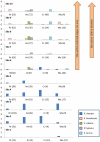Flea diversity as an element for persistence of plague bacteria in an East African plague focus
- PMID: 22530057
- PMCID: PMC3329458
- DOI: 10.1371/journal.pone.0035598
Flea diversity as an element for persistence of plague bacteria in an East African plague focus
Abstract
Plague is a flea-borne rodent-associated zoonotic disease that is caused by Yersinia pestis and characterized by long quiescent periods punctuated by rapidly spreading epidemics and epizootics. How plague bacteria persist during inter-epizootic periods is poorly understood, yet is important for predicting when and where epizootics are likely to occur and for designing interventions aimed at local elimination of the pathogen. Existing hypotheses of how Y. pestis is maintained within plague foci typically center on host abundance or diversity, but little attention has been paid to the importance of flea diversity in enzootic maintenance. Our study compares host and flea abundance and diversity along an elevation gradient that spans from low elevation sites outside of a plague focus in the West Nile region of Uganda (~725-1160 m) to higher elevation sites within the focus (~1380-1630 m). Based on a year of sampling, we showed that host abundance and diversity, as well as total flea abundance on hosts was similar between sites inside compared with outside the plague focus. By contrast, flea diversity was significantly higher inside the focus than outside. Our study highlights the importance of considering flea diversity in models of Y. pestis persistence.
Conflict of interest statement
Figures




References
-
- Link VB. A history of plague in the United States. Washington, DC: Public Health Service; 1955. 120 - PubMed
-
- Tikhomirov E. Epidemiology and distribution of plague. In: Dennis DT, Gage KL, Gratz N, Poland JD, Tikhomirov E, editors. Plague Manual: Epidemiology, Distribution, Surveillance and Control. Geneva: World Health Organization; 1999. pp. 11–37.
-
- Campbell GL, Hughes JM. Plague in India - a New Warning from an Old Nemesis. Ann Internal Med. 1995;122:151–153. - PubMed
-
- Eisen RJ, Enscore RE, Biggerstaff BJ, Reynolds PJ, Ettestad P, et al. Human plague in the southwestern United States, 1957–2004: Spatial models of elevated risk of human exposure to Yersinia pestis. J Med Entomol. 2007;44:530–537. - PubMed
Publication types
MeSH terms
LinkOut - more resources
Full Text Sources
Medical

